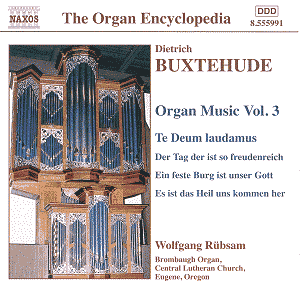Comparison: René Saorgin/Harmonia Mundi
Dietrich Buxtehude represents the pinnacle of
the "Stylus Phantasticus" movement that had its origins
with the music of early 17th century composers such
as Matthias Weckmann and Heinrich Scheidemann. Essentially, this
movement entailed the blossoming of freedom and flexibility in
the structuring of compositions.
In the area of Baroque organ music, only Johann
Sebastian Bach surpasses Buxtehude. He has left us a wonderful
legacy of organ music ranging from the setting of Chorales through
the variations of a Ciacona or Passacaglia to the flight, energy,
variety and expressive freedom of the Praeludium.
Although there are many Buxtehude organ recordings
on the market, most of them never see the light of day in your
typical record store. I suppose the reason has to do with the
thinking that organ music of the Baroque period, prior to Bach,
is overly severe and somber. Since this seems to be a premise
that won’t recede, those wanting Buxtehude organ discs must deal
directly with applicable record companies or purchase on the Internet.
Naxos has been embarked on a complete cycle of
the Buxtehude organ works and finally has released Volume 3 performed
by Wolfgang Rübsam who has been one of our most esteemed
Baroque organists for the last thirty years. Rübsam’s crowning
glory on record is the complete cycle of Bach organ music, also
on Naxos. That is a compelling series as Rübsam offers highly
distinctive and incisive interpretations loaded with sharp contours
and strong punctuation. Given his approach to Bach, it would appear
that the music of Buxtehude would be second nature to Rübsam.
I will often be mentioning the René Saorgin
complete box set of Buxtehude’s organ music. This is excellent
and is played on historical Schnitger and Silbermann organs. The
1976 Brombaugh organ used by Rübsam has fine tone and detail,
but it can’t match the sweetness of the historical organs. As
I have commented in previous reviews of Baroque organ music, the
sweetness of the organ is a significant factor in providing contrast
with the inherent severity of the music.
Although the sound on the new Naxos offering
is certainly adequate, there is a rather excessive amount of air
to contend with, and the soundstage tends to encompass only the
areas toward the center. The result of these two features is reduced
incisiveness and foundation. Generally not debilitating, I do
find the sound characteristics to detract from Rübsam’s performances.
As for the performances themselves, Rübsam
gives us one of the better Buxtehude organ recitals on record.
Yet, I miss the all-consuming power, purpose and severity he invests
in his Bach series. Whether or not one agrees with Rübsam’s
approach to Bach, it surely stands out in the crowd. Such is not
the case with his Buxtehude interpretations.
Here are a few highlights of my journey through
the disc:
Praeludium in F sharp minor – A Buxtehude Praeludium
is the perfect example of the height of the "Stylus Phantasticus"
approach to music. In the F sharp minor, Buxtehude starts us off
with a strong and angular toccata-like section followed by a chordal
section of intense gravity. Two Fugues then appear, the first
marked "grave", the second marked "vivace".
The work ends with an extended free section giving the organist
another opportunity to convey power, improvisation, and edge.
Rübsam delivers a finely honed performance
with plenty of edge, strength, and rhythmic appeal. The only significant
difference with the Saorgin version is that Rübsam is much
slower in the two Fugues, and the "grave" section definitely
benefits from the more reflective and slower treatment.
"Christ unser Herr zum Jordan kam"
– Rübsam loses me on this one with a thoroughly drab performance.
Much of the problem is likely due to the diffuse sound I mentioned
above; the music simply has no foundation, and therefore, no gravity.
Switch to Saorgin and the music has weight and conveys deep despair.
Take away the despair, and this Chorale has little to offer. Rübsam
exacerbates the effect with rather discrete registrations, and
I end up very disappointed.
"Der Tag der ist so freudenreich" –
Rübsam rebounds beautifully with this uplifting music. As
usual, he employs a slower tempo than Rogg, and it again is beneficial.
The Chorale’s title translates into "The day that is so joyful",
and Rogg is so quick that he sounds as if he’d like the day to
hurry up. In contrast, Rübsam savors the music while also
giving it a lightness that is very refreshing. Exceptionally done.
"Te Deum laudüamus" – This five
movement work consists of a Praeludium and four verses. The first
verse, "Te deum laudamus" is my favorite piece on the
disc and begins with twisting notes and phrasing which eventually
are taken over by a chordal section emphasizing the long lines
of the tremendous bass accompaniment. Rübsam is in his element
here, as nobody twists phrasing as expertly or highlights the
heroic severity of the chordal music with such great sweep.
In conclusion, the new Rübsam disc deserves
a strong recommendation, but the performances do not have the
visceral impact Rübsam invests in his Bach recordings. A
less than ideal organ and soundstage also hold the recording back
from being one of the exceptional Buxtehude organ discs. Between
Rübsam and Saorgin, I have to side with Saorgin. The performances
are roughly equal in quality, but the engineering and choice of
organs are in Saorgin’s favor.
Don Satz
